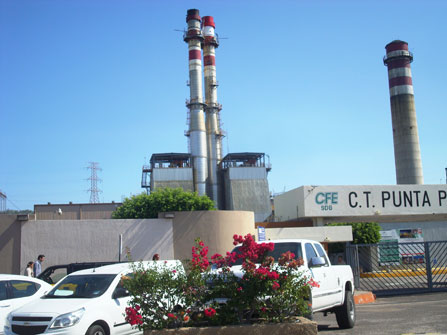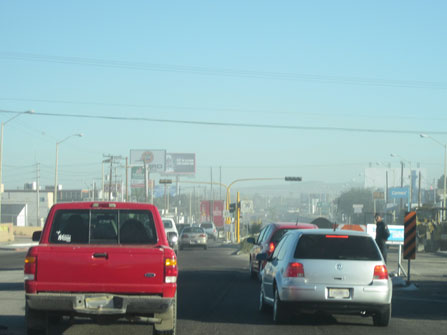Industry reports toxic residues in Baja California Sur

The CFE in La Paz is one of Baja California Sur's five industries that made voluntary reports of their toxic wastes (Photo: Talli Nauman).
LA PAZ
Industry in Baja California Sur emits 14 toxic substances and their compounds into the air, water or soil: acetaldehyde (ethanal), sulfuric acid, acrolein (propanal), arsenic, benzene, carbon dioxide, cadmium, inorganic and organic cyanide, chromium, formaldehyde, mercury, nickel and lead. Thirteen of these are present in the state capital, La Paz.
The information was gathered from the most recent reports made by those installations subject to annual, mandatory, government reporting via the Pollutant Release and Transfer Register (PRTR).
In Baja California Sur, 638,461 pounds of contaminants were released into the air, 40,928 pounds into the water and 2,394 pounds into the ground. During this time, only 40.4 pounds were sent to a disposal facility, and 0.7876 pounds were flushed into the sewage system.
The emissions of the greenhouse gas CO2 reached 2,769,671 tons.
The information in the PRTR published in 2013 represents emissions for 2012. It is available through the Secretariat of the Environment and Natural Resources (Semarnat), the governing body for the program.
With the new Mexican law (NOM-165) published January 24, it is expected that beginning in 2014, an improvement in the quality and quantity of available information on toxic emissions from fixed sources in Baja California Sur will be available, in addition to data from the rest of the country.
For the first time, the measure requires companies to report to the PRTR the location and quantity of toxic waste produced as a by-product.
To date, five companies in Baja California Sur emitting toxic substances that merit monitoring by the federal government have submitted data to the PRTR.
Those that reported voluntarily, without coercion from Semarnat, were: the Federal Electricity Commission (CFE), the principal electricity generator; Exportadora de Sal, which operates an evaporative salt works facility which also produces chemical byproducts; Petróleos Mexicanos (Pemex), the country’s oil and petrochemical company; the hotel business Promociones Turísticas; and Roca Fosfórica Mexicana II which reports under the classification of minerals, iron and steel manufacturing.
So far, toxic emissions have been reported in four of the state’s five municipalities: La Paz, Los Cabos, Comondú and Mulegé. None were reported in the municipality of Loreto.

La Paz – The burning of fossil fuels from both vehicles and electricity plants have made the city's smog infamous (Photo: Debra Valov).
In the most recent reporting year, 1,754,845 tons of residues were released into the air of the state's capital city, almost exclusively from CFE, while Pemex reportsed that it only released three tons.
Pemex was the only industy emitting acetaldehyde (0.308 pounds per year), acrolein (0.0044 pounds) and benzene (0.374 pounds per year). Meanwhile the CFE and Roca Fosfórica are responsible for arsenic contamination of water sources, releasing 839 pounds per year.
The CFE released 4,718,660 pounds of NO2, and together with Roca Fosfórica emitted 9,908 pounds of inorganic cyanide into the water and 1.19 pounds into the soil.
The CFE, Pemex and Roca Fosfórica contaminated La Paz’s water with 1,004 pounds of cadmium per year and its soils with 0.737 pounds. Except for Pemex, these same industries emitted 50,787 pounds of chromium into the water and 3.85 pounds into the soil.
In 2012, the CFE and Roca Fosfórica contaminated water with 257 pounds of mercury and soils with 0.0264 pounds. These two industries along with Promociones Turísticas and Pemex disposed of 82,145 pounds of nickel in the water and 3.5 pounds in the ground.
The CFE and Pemex were the source of lead contaminacion, having released 44,120 pounds into the water and 0.55 pounds into the soil.
Finally, the records for for La Paz and Baja California Sur show Pemex had emissions of 0.0016 pounds of formaldehyde into the air.
According to Agustín Bravo, La Paz representative of the Mexican Environmental Law Center, knowing the quantities emitted helps in the analysis of human and environmental health, which must take into account the impacts on different segments of the population.
The CFE divulges little about the relationship between its contaminants and their effects on health, Bravo said. He proposes that the CFE takes responsibility for carrying out age-related epidemiological studies with the elderly, adults, and children.
The thresholds considered safe for Mexicans, as set by laws and regulations, have not been updated since the beginning of this century, and most are higher than those adopted by Canada and the United States.
Efforts by civil society to reduce the thresholds and to add new toxic substances to the mandatory reporting list met with resistance from industry representatives who took part in Semarnat negotians for the NOM-165 during 2013.
The number of substances subject to mandatory reporting was finally set at 200 but the thresholds were not changed. That job was left for future consideration by all sectors involved.
The Mexican registry is part of a tri-national effort to reconcile the country’s data with those of the United States and Canada, as a part of the environmental side-accord to the North American Free Trade Agreement. Dissemination of this information is free to the public.
When Rafael Pacchiano Alamán, Semarnat’s assistant secretary for Environmental Protection Management, presented the results of the 2012 reporting cycle, he noted that Mexico’s PRTR also meets commitments made to the Organization for Economic Cooperation and Development (OECD) for strengthening the public’s right to environmental information access.
He announced that, within the framework of the North American Commission for Environmental Cooperation (CEC), Mexico, the United States, and Canada will soon be publishing an analysis of the North American PRTRs for 2005–2010.
